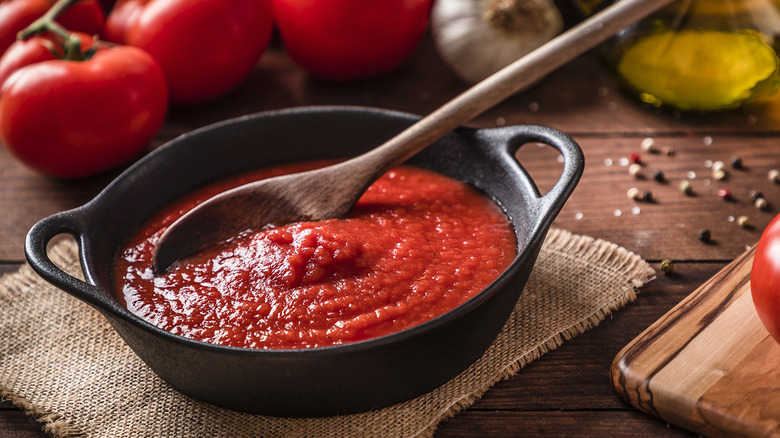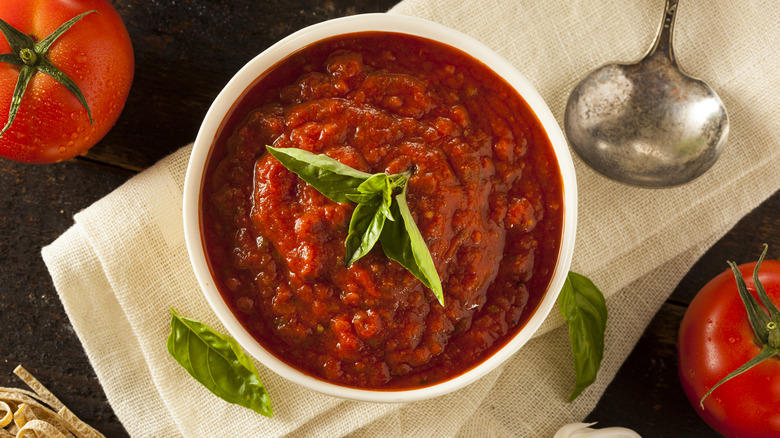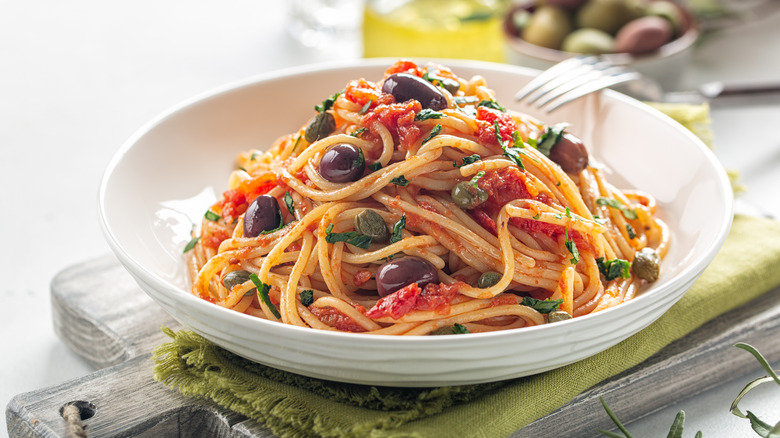Pomodoro Is The Ideal Tomato Sauce For Lazy Home Cooks
Italy's cuisine is rich with variety across its 20 regions, but pasta is one of the country's most famous exports. So many Italian pasta dishes start with a tomato-based sauce, and pasta al pomodoro (pasta with tomato sauce) is as classic as it gets. Made of canned tomatoes, garlic, and olive oil, perhaps with a little basil, pomodoro is one of the simplest and most straightforward sauces for home cooks to make from scratch.
The first printed recipe for basic tomato sauce was published by Antonio Latini, a chef who lived in Naples, back in 1694. But it wasn't until the 19th century that pasta with tomato sauce really took off in Italy. Now, it's an iconic combination synonymous with the country, served in every manner from easygoing Neapolitan street food to elevated fine dining, not to mention it's enjoyed in countless other places around the globe.
As you might imagine from the name, pomodoro all about celebrating the fresh, vibrant taste of the tomatoes, which makes it incredibly quick and easy. You won't find any long simmering times or copious flavorings here. Though they may have some similarities, pomodoro and marinara sauce — another super-popular tomato sauce — are not the same thing. But fans of marinara will be happy to learn that pomodoro is even simpler to make, and just as tasty.
Pomodoro and marinara have different ingredients
Pomodoro and marinara almost look identical, but they have a few key differences. The first comes down to the ingredients. Pomodoro consists of just tomatoes, garlic, olive oil, and perhaps basil, with no additional herbs, spices, or vegetables. Marinara, on the other hand, is basically a pomodoro with some extra fixings, such as finely-chopped vegetables like onions, celery, and carrots. It might also contain oregano, dried bay leaves, or crushed red pepper. These additions give marinara a chunkier texture than pomodoro, too, which is usually smoother.
The simplicity of pomodoro sauce means it's easier to than marinara, with no extra peeling or chopping required beyond the tomatoes. In fact, most recipes call for good-quality Italian canned tomatoes, speeding things up even further. While plenty of tomato sauces — those family recipes passed down by Italian grandmothers — call for simmering the ingredients all day, pomodoro is much faster. A long cooking time would muddy the tomatoes, so pomodoro can be whipped up on a weeknight in a flash, unlike marinara or even more involved sauces like tomato-based "Sunday gravy."
Though both sauces pair well with pasta, as well as dishes like lasagna and chicken parmesan, pomodoro and marinara's unique attributes also make them suited for specific purposes. Pomorodoro's spreadability makes it a good pizza sauce, for example, while marinara can be used as a dipping sauce.
Other flavorful tomato sauces build on a basic pomodoro
While a classic pomodoro sauce is a must-try for home cooks who want a tasty dinner with almost zero effort, there are also ways to elevate this basic tomato sauce recipe with a number of additional ingredients. Once you have your tomatoes and other ingredients all cooked in a pot, you can customize the mixture according to your mood.
Add extra garlic (try the traditional elephant garlic or purple garlic) to make aglione, a garlicky tomato sauce to pair with pici pasta. Spice things up with a recipe for arrabbiata, a fiery sauce which adds red pepper flakes or chile to a basic pomodoro. Or bring briny, salty flavors to the tomatoes with anchovies, capers, and olives for a homemade puttanesca sauce to go with spaghetti.
Pomodoro sauce can last for up to five days in an airtight container in the refrigerator, so try using any leftovers as a base for boozy, creamy pasta alla vodka. Or add chopped bacon, pancetta, or guanciale with chiles for a classic Southern Italian style bucatini all'Amatriciana. Effortless to make yet easy to elevate, it's simple to see why pomodoro is such a classic sauce, and it's one that even the laziest home cook can master.



